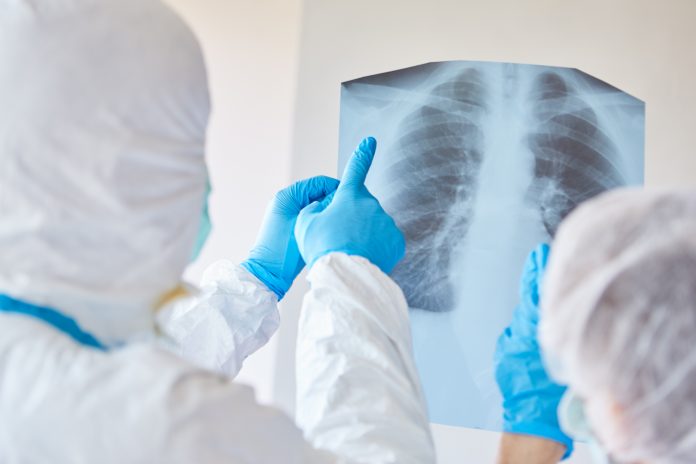The brightest ever X-ray has shown damage caused by COVID-19 in the lungs’ smallest blood vessels, using high-energy X-rays released by a special particle accelerator
Scientists from UCL and the European Synchrotron Research Facility (ESRF) used a new revolutionary imaging technology called Hierarchical Phase-Contrast Tomography (HiP-CT), to scan donated human organs, including lungs from a COVID-19 donor.
Hierarchical Phase-Contrast Tomography (HiP-CT), enabling a range of 3D mapping, allows clinicians to zoom down to a cellular level as well as view the entire organ.
Using X-rays supplied by the European Synchrotron (particle accelerator) in France, this technique now provides the brightest source of X-rays in the world at 100 billion times brighter than a hospital X-ray.
This is due to its recent Extremely Brilliant Source upgrade (ESRF-EBS), which now allows researchers to view blood vessels five microns in diameter (a tenth of the diameter of a hair) in an intact human lung. In comparison, a clinical CT scan only resolves blood vessels that are about 100 times larger, around 1mm in diameter.
“ESRF-EBS has allowed us to go from deciphering the secrets of fossils to seeing the human body as never before.”
Dr Claire Walsh (UCL Mechanical Engineering) said: “The ability to see organs across scales like this will really be revolutionary for medical imaging. As we start to link our HiP-CT images to clinical images through AI techniques, we will – for the first time – be able to highly accurately validate ambiguous findings in clinical images.
“For understanding human anatomy this is also a very exciting technique, being able to see tiny organ structures in 3D in their correct spatial context is key to understanding how our bodies are structured and how they therefore function.”
The research team, with clinicians in Germany and France, have used HiP-CT to see how a case of severe COVID-19 infection moves blood between the two separate systems, the capillaries which oxygenate the blood and those which feed the lung tissue itself.
Though only hypothesised and not currently proven, the research found such cross-linking thus stops the patient’s blood from being properly oxygenated.
Maximilian Ackermann MD (University Medical Center Mainz), clinical user of the technique, stated: “Shortly after the beginning of the global pandemic we demonstrated that COVID-19 is a systemic vascular disease using histopathological (optical imaging of tissue) and molecular methods. However, these techniques did not adequately address the extent of the changes and clotting in fine blood vessels of whole lungs.”
Danny Jonigk, Professor of Thoracic Pathology, (Hannover Medical School, Germany) added: “By combining our molecular methods with the HiP-CT multiscale imaging in lungs affected by COVID-19 pneumonia, we gained a new understanding how shunting between blood vessels in a lung’s two vascular systems occurs in COVID-19 injured lungs, and the impact it has on oxygen levels in our circulatory system.”
Creating the Human Organ Atlas with HiP-CT
With support from the Chan Zuckerberg Initiative (CZI), the UCL-led team are using HiP-CT to produce a Human Organ Atlas, an online tool for surgeons, clinicians and the interested public to learn about the effects of COVID-19.
Displaying six donated control organs: brain, lung, heart, two kidneys and a spleen, and the lung of a patient who died of COVID-19. It will also include a control lung biopsy and a COVID-19 lung biopsy.
Project lead Professor Peter Lee (UCL Mechanical Engineering) said: “The Atlas spans a previously poorly explored scale in our understanding of human anatomy, which is the centimetre to micron-scale in intact organs. Clinical CT and MRI scans can resolve down to just below a millimetre, whilst histology (studying cells/biopsy slices under a microscope), electron microscopy (which uses an electron beam to generate images) and other similar techniques resolve structures with sub-micron accuracy, but only on small biopsies of tissue from an organ.
“ HiP-CT bridges these scales in 3D, imaging whole organs to provide new insights into our biological makeup.”
HiP-CT’s benefit for other diseases
Confident that scale-bridging imaging from whole organ down to cellular level could provide additional insights into many diseases such as cancer or Alzheimer’s Disease, the researchers and authors hope the Human Organ Atlas will eventually contain a library of diseases that affect organs on a range of scales, from 1 to 100s of microns to entire organs, helping clinicians as they diagnose and treat a wide range of diseases.
Clinician Willi Wagner, Radiologist at University Hospital in Heidelberg said: “HiP-CT is filling a vast imaging gap in human medicine: clinical imaging provides 3D data of the body and organs but is limited to a gross scale; histopathology on the other hand provides detailed images of tissues and cells derived from small pieces of organs.
“It is generally limited to a small field and two dimensions. HiP-CT is bridging the organ to tissue scale, tightly linking the clinical disciplines of radiology and pathology and providing never before seen structural data of 3D tissue architecture and disease patterns.”
The team also hope to use artificial intelligence (AI) to regulate clinical CT and MRI scans, and enhance the understanding of clinical imaging, hopefully supporting a faster and more accurate diagnosis.
The full study has been published in the Journal Nature Methods.











